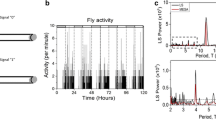Abstract
A mathematical formulation useful in characterizing the effects of light on the pupal eclosion rhythm of the fruit flyDrosophila pseudoobscura is presented. It is based upon the premise that the underlying pacemaker oscillator behaves in a manner analogous to a customized version of a phase-locked loop circuit. Theoretical analyses supplemented with numerical simulations reveal that this phase-locked loop approach yields a concise mathematical characterization which is quite comprehensive in its scope, yet surprisingly accurate in the detail with which it can be used to successfully predict observed experimental results.
Similar content being viewed by others
Literature
Barlow, J. S. 1962. “A Phase-comparator Model for the Diurnal Rhythm of Emergence ofDrosophila.”Ann. N.Y. Acad. Sci. 98, 788–805.
Berde, C. 1976. “Nonmonotonic Transients and Some Mathematical Models of Circadian Rhythms.”J. theor. Biol. 55, 455–470.
Chandrashekaran, M. K. and W. Loher. 1969. “The Effect of Light Intensity on the Circadian Rhythm of Eclosion inDrosophila pseudoobscura.”Z. vergl. Physiol. 62, 337–347.
Engelmann, W. 1969. “Phase Shifting of Eclosion inDrosophila pseuodoobscura as a Function of the Energy of the Light Pulse.”Z. vergl. Physiol. 64, 111–117.
Frank, K. D. and W. F. Zimmerman. 1969. “Action Spectra for Phase Shifts of a Circadian Rhythm inDrosophila.”Science, N.Y. 163, 688–689.
Gardner, F. M. 1979.Phaselock Techniques. 2nd Edn. Somerset, NJ: Wiley.
Kawato, M. 1981. “Transient and Steady State Phase Response Curves of Limit Cycle Oscillators.”J. math. Biol. 12, 13–30.
Lam, H. Y. F. 1979.Analog and Digital Filters: Design and Realization. Englewood Cliffs, NJ: Prentice Hall.
Linkens, D. A., Ed. 1979.Biological Systems, Modelling and Control. London: Peter Peregrinus.
Palmer, J. D. 1976.An Introduction to Biological Rhythms. New York: Academic Press.
Pavlidis, T. 1967a. “A Mathematical Model for the Light Affected System in theDrosophila Eclosion Rhythm.”Bull. math. Biophys. 29, 291–310.
— 1967b. “A Model for Circadian Clocks.”Bull. math. Biophys. 29, 781–791.
— 1978a. “What Do Mathematical Models Tell Us about Circadian Clocks?”Bull. math. Biol. 40, 625–635.
— 1978b. “Qualitative Similarities Between the Behavior of Coupled Oscillators and Circadian Rhythms.”Bull. math. Biol. 40, 675–692.
Pittendrigh, C. S. 1960. “Circadian Rhythms and the Circadian Organization of Living Systems.”Cold Spring Har. Symp. quant. Biol. 25, 159–184.
— 1965. “On the Mechanism of Entrainment of a Circadian Rhythm by Light Cycles.” InCircadian Clocks, Ed. J. Aschoff, pp. 277–297. Amsterdam: North Holland.
— 1966. “The Circadian Oscillation inDrosophila pseudoobscura Pupae: A Model for the Photoperiodic Clock.”Z. PflPhysiol. Bd. 54, 275–307.
— 1974. “Circadian Oscillations in Cells and the Circadian Organization of Multicellular Systems.” InNeurosciences Third Study Program, Eds. F. O. Schmitt and F. G. Worden, pp. 437–458. Cambridge, MA: M.I.T. Press.
— 1976. “Circadian Clocks: What Are They?” InThe Molecular Basis for Circadian Rhythms, Eds. J. W. Hastings and H. G. Schweiger, pp. 11–48. Berlin: Dahlem Konferenzer.
— and V. Bruce. 1957. “An Oscillator Model for Biological Clocks.” InRhythmic and Synthetic Processes in Growth, Ed. D. Rudnick, pp. 75–109. Princeton: Princeton Univ. Press.
— and D. H. Minus. 1964. “The Entrainment of Circadian Oscillations by Light and their Role as Photoperiodic Clocks.”Am. Nat. 98, 261–294.
Sansone, G. and R. Conti. 1964.Non-linear Differential Equations, New York: Pergamon Press.
Schilling, R. J. 1981. “A Parametric Model for the Entrainment of a Circadian Rhythm by Daily Light Cycles.” InBioengineering, Proc. Ninth NE Conf., Ed. W. Welkowitz, pp. 317–321. New York: Pergamon Press.
Schilling, R. J. In press. “Control of a Biological Clock with Light”.Int. J. Systems Sci.
Vidyasagar, M. 1978.Nonlinear Systems Analysis. Englewood Cliffs, NJ: Prentice Hall.
Winfree, A. T. 1970. “An Integrated View of the Resetting of a Biological Clock.”J. theor. Biol. 28, 327–374.
— 1972. “Slow Dark-adaptation inDrosophila's Circadian Clock.”J. comp. Physiol. 77, 418–434.
— 1973. “Resetting the Amplitude ofDrosophila's Circadian Chronometer.”J. comp. Physiol. 85, 105–140.
— 1974. “SuppressingDrosophila's Circadian Rhythm with Dim Light.”Science, N.Y. 183, 970–972.
— 1980.The Geometry of Biological Time. New York: Springer-Verlag.
Author information
Authors and Affiliations
Rights and permissions
About this article
Cite this article
Schilling, R.J. A mathematical model of the effects of light on the eclosion rhythm of the fruit flydrosophila pseudoobscura . Bltn Mathcal Biology 45, 169–192 (1983). https://doi.org/10.1007/BF02462355
Received:
Revised:
Issue Date:
DOI: https://doi.org/10.1007/BF02462355




